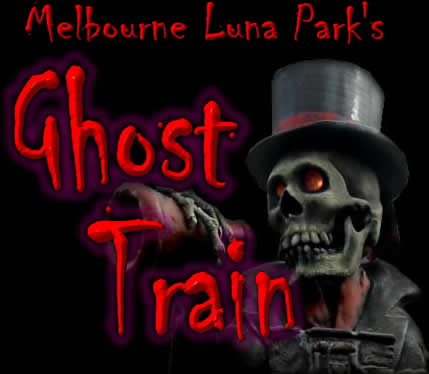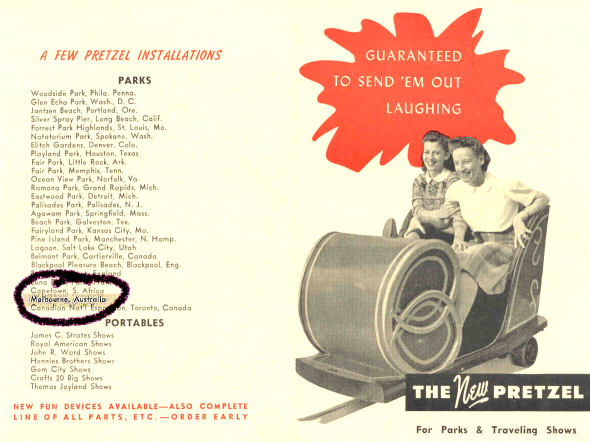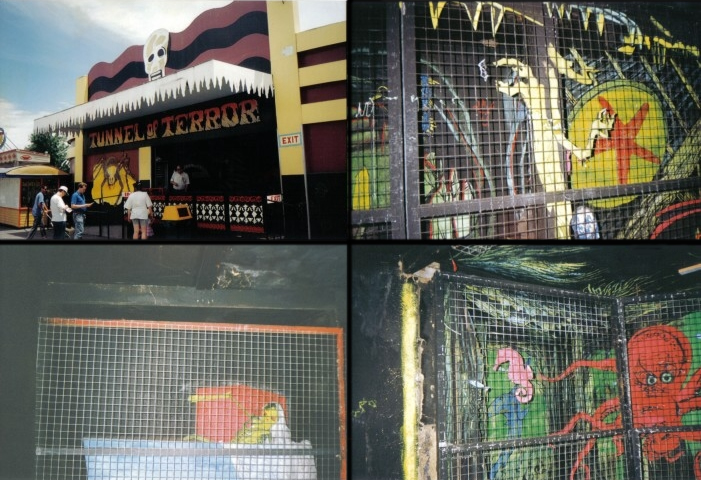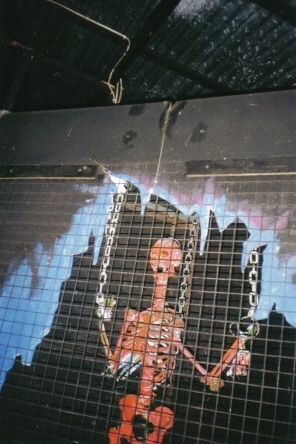

 |

By Robert Lashmore
Luna Park. Playground of Victoria's young and old alike for years.
If you were to ask for a history of this historic amusement centre, it would go along these lines:
|
On 2 November 1906, Mr E S Salambo opened “Dreamland” which was an outdoor amusement park situated approximately where Luna Park stands today. Its attractions included Mt Fujiyama, The Rivers of the World, the Destruction of San Francisco, the Underworld, the Figure-8, a Grecian Theatre, an airship and a band. The venture failed after three seasons, possibly due to its high entrance price. Dreamland was demolished in 1909, but one ride, The Figure-8, located approximately on the site of the Palais Theatre, was popular enough to be retained. It was a primitive type of roller-coaster and remained until about WWI. The Greater J.D. Williams Amusement Company acquired a lease on the land in 1911 to build a new amusement park for a ten year period at £400 per annum. James Dixon Williams had moved to Australia from Canada with the intention of expanding his amusement interests. Together with Herman, Harold and Leon Phillips from Seattle, and 20 other imported American fun fair experts, the company began work on the construction of Luna Park. The chief designer/ builder was T. H. Eslick who had worked in the amusement park industry for over 14 years in many countries. The Scenic Railway is reportedly a replica of the roller-coaster he built for The Great Durbar Exhibition of Old Bombay for the visit of King George V in 1911. His stay in India is thought to be the inspiration for the Moghul/ Moorish entrance facade and flanking towers built at Luna Park.
Other key instigators with experience at Coney Island were Louis Corbeille who was responsible for many of the original illusions and effects, and the Whitney Brothers George and Leo Whitney (Warren Crandall's Mother's Uncles) who invented the while-you-wait photographic studio first seen at Luna Park, Coney Island.
The design of the park was quite open, with attractions arranged around the perimeter except for the Bowl Slide and the Ferris Wheel. The centre was also the location for most of the live entertainment, particularly a high-wire for acrobatic performances. Many sideshows had their own styles, such as the Pharaoh's Daughter which was Egyptian. Moon symbols were incorporated into the tea-terrace balustrades. The whole complex at night was a blaze of light with no fewer than 80,000 electric lights.
The park's opening in December 1912 was an immediate success and drew large crowds. Some of the original attractions included the Scenic Railway roller coaster, the River Caves (a romantic boat journey through exotic scenes), the Pharaoh's Daughter (an exotic performance auditorium also known as the Egyptian Theatre), the American Bowl Slide (a giant slide down a chute into a revolving bowl of polished wood), the Palais de Folies (incorporating the Whitney Electric Photographic Studio), the Palace of Illusions (which exhibited the genius of Louis Corbeille), the Terrace Tea Gardens (where 2000 patrons could enjoy tea on a terrace perched above the river caves with views of the bay), the Ferris Wheel and numerous American slot machines (that used dimes). A main attraction at the park was live entertainment which included the Luna Park Band, high wire performances, performing animals, acrobats, trick cyclists, a troop of midgets, and a Swedish diver, Miss Thelin who dove into a pool from a 50 ft tower into a tub of blazing water with her clothes alight.
During the winter of 1913, the Phillips brothers stayed on and revamped the Park. New scenes were added to the River Caves, the Scenic Railway was overhauled, the Palais de Folies was extended, the American Bowl Slide was removed, and the temples and pavilions were renovated and repainted. New sideshows for the 1913/ 14 season included a Hoopla Bazaar (incorporating the Canadian Log Walk), Aunt Jemima's Washing Day (where a Negro woman was situated above a wash tub and fell in when hit), the Egyptian Palace of Fortune, Poker Toss, Ping Pong Pitch, Association High-Kick, the Chocolate Derby, the Arabian Dart Game and the Melbourne Joy Club (in which the aim was to knock the hats off 16 upper crust inebriates rolling out of a pub).
In early 1914 The Argus reported that Luna Park was drawing 8,000 to 10,000 people each Saturday night. With war imminent, 1914 saw more patriotic themes appearing. The River Caves were filled with British and Australian Naval history and monuments, and the Kaiser's Kitchen in the Palace of Illusions was a game in which patrons hurled crockery at an effigy of Kaiser Wilheim II.
The 1914/15 and 1915/16 seasons were also successful, but in 1916 Luna Park was forced to close for the War. The Scenic Railway remained operating, but the Park as a whole was only opened for patriotic events.
After a dispute over the lease and difficulties getting materials due to the War, Luna Park was not reopened until 1923. The interior of the Park was transformed, and only the Scenic Railway, the Palais de Folies (renamed ‘Funnyland'), and the River Caves were essentially the same as before the War. New attractions included a Carousel, The Whip, a Water Chute, Noah's Ark, and the Big Dipper, which in its day was known as the Supreme Thrill Machine. The photo studios were renovated and the River Caves were remodelled to resemble the tropics. A fake mountain, complete with goats and model Swiss Chalets, was probably constructed in this year, over the River Caves, and partly obscured the Big Dipper. The Park was renamed the ‘New Luna Park' and advertising was aimed at children who were admitted free to Saturday Matinees. The Dodgem was installed for the 1926-27 season. A complete new building, in an eclectic French-Chateau style, was built over the Whip, with the Dodgems installed on the first floor. A new Scenic Railway Station was also probably built at this time as well. In 1926 the Phillips company was also undertaking the construction of the Palais Picture Theatre. For the 1928 season, the Water Chute was remodelled into the Jack and Jill (a ride similar to the American Bowl Slide), and the Goofy House was added. In 1934 more rides were purchased including The Caterpillar and The Pretzel (an original Pretzel Company Installation - see image below), but the season was marred by the first death on the Big Dipper. The Whirler was probably added at this time. |

The mid 1930's was the beginning of the international Big Band era, and competitions were held at Luna Park. For the season of 1937-38, to commemorate the Parks 25th anniversary, the Carousel enclosure was redecorated to resemble a birthday cake. the Pretzel was re-themed as The Ghost Ride.
TIngram.jpg)
A new Big Dipper station, resurrecting the earlier oriental style, was also probably erected at this time.
|
The Second World War forced Luna Park to operate under blackout conditions but was a popular attraction for the scores of visiting American servicemen. Like the rest of St Kilda, Luna Park became more heavily associated with sexual desire, and loosening morals. With post-war restrictions, little investment was made until 1951. The Carousel, Dodgems, Jack and Jill, and Penny Arcade were at long last renovated and the popular Rotor was installed. The Rotor ride had been recently patented and a matching example was also built in Sydney in 1951. Over the next thirty years, Luna Park struggled to maintain the popularity it had developed early in its life. A series of new owners with little real vision or commitment came and went, leaving behind a Park in desperate need of major capital reinvestment. It was during this period that the Ghost Ride was rethemed as the "Tunnel Of Terror" |


| By the 1980's, the Australian perception of an Amusement Park was heavily influenced by visits to and images from major Theme Parks such as Disneyland, not to mention major Theme Parks on Australia's Gold Coast. In 1993, the Park's owner set about drafting as grand new Development Plan, which included the restoration of the Park's remaining heritage features and the installation of state-of-the-art attractions. He managed to secure a long lease over the site and then proceeded immediately to sell the Park. At the time, the community feared that Luna Park would once again fall into the hands of shortsighted owners with little imagination or commitment. The grand Development Plan remained just that, for several years afterwards.
The park was finally sold in 1998 to a major investor in Australian tourism assets. BCR Asset Management adopted the key heritage elements of the Development Plan and proceeded to refurbish and restore the landmark features of the Park such as the “Mr Moon” entrance façade, the Scenic Rail, the 1934 Pretzel Ride, and the 1913 PTC#30 Carousel. In April 2001, the Park closed for one of the few times in its history in order to complete the $10M AUD refurbishment of the 1.5 hectare Park. With the exception of the Park's heritage structures, the entire park was stripped bare and a major construction exercise began to reinstall the Park's infrastructure and some of its existing attractions. This was when the Tunnel Of Terror was refurbished and presented as the current Ghost Train. The Park also added nine new rides as well as adding a three hundred seat function room. On October 1st 2001, a mere five months after its closure, the Park re-opened to the public to rave reviews and capacity attendance. It seemed that the new Luna Park was once again exciting and delighting generations of Australians and retaking its place in the hearts and minds of the community. Since the redevelopment in 2001, the Park continues to improve its annual visitation and revenue and plans are now underway to add more new attractions and facilities. ....And that's where we find ourselves today. |